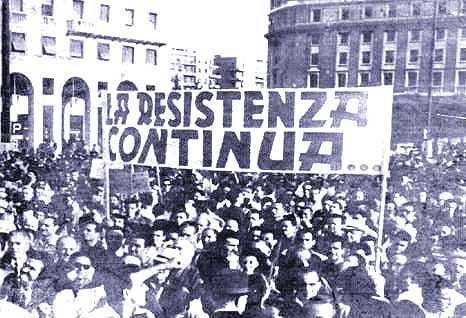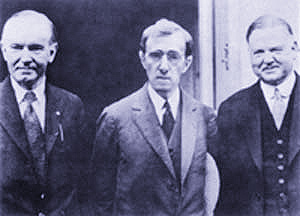A Few Quick Notes on Social Conflict in Italy and the Metaphors Used to Describe It (*)
Wu Ming 1, December 2002
A match used to show off like this:
- I'm able to set a barn on fire! I can set fire to a petrol tank, the seat of a ministry, an Etruscan museum, whatever!
- Why not just say you're able to light the gas and boil the soup?
We always show off about the worst things.
Gianni Rodari, "Minimal Fables"
Some people have called the Italian insurgence of 2000-02 "la Primavera dei movimenti", the Springtime of Movements. That is also the title of a video documentary that was sold in newsstands enclosed with L'Unità daily paper.
In 1969 the biggest struggles of factory workers were described as "Autunno caldo", the Hot Autumn. Recently, it is quite normal to hear such comments as: "It's like the Hot Autumn!" or "It's the Hot Autumn again!".
Social conflict is endemic and natural, thus it is quite appropriate to use seasonal metaphors to describe it.
Nobody can deny that Italy is living a new, hot season of struggle and social turmoil. Conflict is multi-layered and manifold: there is a "molar" aspect related to huge mass mobilisation, involving the biggest general strikes in Europe and the biggest political demonstrations ever; perhaps more important, there is a "molecular" aspect, related to everyday activism, hacktivism, guerrilla communications and the building of direct democracy: social forums at municipal and regional levels, independent media projects springing up like mushrooms, the hard battle on copyright and intellectual property and so on.
It is impossible to give a full account of what is going on, and I won't even try.
A tradition. In latin the verb "tradere" simply meant "to hand down something", it did not entail any narrow-mindedness, conservatism or forced respect for the past.
Revolutions and radical movements have always found and told their own myths. They often got trapped in the iron cages of their own myths: their traditions and rituals became alienating, the continuity between past and present was *imposed* on the people instead of being proposed.
Radicals of all ages over-reacted to that situation by becoming iconoclastic, by trying to de-mythologize the imagery and discourse of the movement. By doing that, they simply replaced one alienating imagery with another. Iconoclasty soon became a new iconophilia. The pro-situs who adore St. Guy of Paris are only one of the most striking examples of this. As a consequence, misery and impotence rule, bitter nihilism and defeatism replace theory, and fools rush into the nearest dead end street (primitivism, technofobia etc.)
Myths are necessary. We couldn't live together without stories to tell and listen to, without "heroes" whose example we can follow or reject. Our language, our memories, our imagination and our need of forming communities are the things that make us human beings, and the stories keep them all together. There is no way we can get rid of myths, and why the fuck should we? Instead of wasting our time listening to some bullshitter who poses as the most radical of all, we ought to understand the way actual social movements want to fullfill their need for myths and mythologies, and help them keep mythologies lively, flexible and in motion.
As far as this kind of experimentation (radical "mythopoesis") is concerned, Italy's always been an exciting laboratory. For many historical and social reasons , the Italian social movements were able to emerge as multitudes of people describing themselves by an endless, lively flow of tales, using those tales as weapons in order to impose a new imagery from the grassroots. When we talk about "myths", we mean stories that are *tangible*, made of flesh, blood and shit. As we tried to explain several times to people who live in other countries, *mythopoesis* is what enriches the Italian movements.
1. Italy from a Bird's Eye View
 Genoa, 30 June 1960 |
Not even Italians are able to fully understand Italy's political history, because we are talking about total chaos, mayhem, black operations by the Intelligence [actually, counterinsurgence] services and almost constant rioting in the streets. Italy was one of the most important outposts of the Cold War, because it bordered with Yugoslavia, had the most powerful and influential Communist Party in the Western Hemisphere (mainly because communists had led the armed Resistance and helped kick the Nazis out of the country) and was (nay, still is) at the center of the Mediterranean Sea, therefore "dangerously" close to Lybia, the Middle East and so on.
Hidden powers of all sorts fought dirty wars in this country since the fall of the Fascist regime. In 1948 the CIA and the Vatican did all they could to make the Christian Democrat Party win the national election, they even staged "appearances" of the Virgin Mary all across Southern Italy. It goes without saying that Our Lady warned people to vote against the People's Front [the coalition of socialists and communists].
That was the beginning of the so-called "K Factor", which meant the the Italian Communist Party (PCI) and its allies had to be kept out of national government, in spite of getting more than the 30% of votes (and keeping them well into the 1980's).
The PCI was not an uptight Stalinist party, or rather, it had unmistakeable Stalinist features, but it also was a popular party that shared some features with North-European Social Democracy and based its politics upon "cultural hegemony", a concept devised by the party's founder Antonio Gramsci, one of the most brilliant and inspirational Marxist thinkers of the 20th Century, who died in a Fascist penitentiary in 1937. The PCI, unlike its brother parties in Western Europe, tugged sharply at the umbilical cord and got ever more independent of the USSR. This process started in the late 1960's and ended in 1982 with what became renowned as "lo Strappo", The Tearing.
At least one third of the country, including my native region - Emilia Romagna, whose capital is Bologna - had communist local administrations. The biggest Italian trade union, CGIL [Italian General Federation of Labour, which still has a membership of 5 million workers], was very close to the PCI.
Everything that happened in Italy in the past 50 years had to do with America's necessity to "tame" the left-wing, the unions and the movements. The US kept in office a ludicrously corrupted Christian Democrat government, which was continually thrown into legitimacy crises because of scandals, strikes and mutual back-stabbing within the coalitions.
In the summer of 1960 the situation had grown so unstable that the Christian Democrats endeavoured to prop up their government by involving the Italian Social Movement, i.e. the neo-Fascist Party. As a consequence, riots flared up in many cities, especially in Genoa, where young workers fought the police and prevented the Fascists from holding their party congress in a town that was awarded with the gold medal of Resistance. The prime minister Fernando Tambroni ordered the police to fire. Several demonstrators were injured and killed in Reggio Emilia and Licata. Tambroni was forced to resign and was replaced by a less reactionary premier. Since striped T-shirts were in fashion among the youth and all the Genoa rioters happened to wear them, that battle made history as "the revolt of striped T-shirts". As to the political situation, it continued to be very unstable: from 1948 to 1989 Italy changed prime ministers about 50 times.
The most difficult times were after the Hot Autumn, when incredibly huge and radical mass mobilisations faced the fiercest repression by the powers-that-be. A brief history of this is in the Introduction to Luther Blissett's essay Enemies of the State. The 1969-80 campaign of black operations against the left - the so-called "Strategy of Tension" - was possibly the darkest period for Italian public life.
Because of general and unstoppable corruption, the whole political system sort of collapsed in the early Nineties, when the amount of scandals and investigations piled up out of sight and the ruling class understood that a political change could not be delayed. The Christian Democrats, the "Socialists" (which actually had become a right-wing party, and the most corrupted of all) and all the major parties were beheaded and then disbanded.
Silvio Berlusconi, whom corruption and political alliances had turned into one of the biggest tycoons, was running the risk of being thrown to jail, thus he decided to build a big political machine and take the field directly. He started to support and fund the old Italian Social Movement (i.e. the old-fashioned Fascist party), the only right-wing party untouched by the campaign for "clean hands" (mainly because it always was too dirty to be involved in any level of government). The Fascists put some make-up on their ugly faces and became Alleanza Nazionale, which describes itself as a "centre-right conservative party", but actually little has changed in their ideological DNA.
The current government is a bunch of mafiosi, corporate managers, lawyers of the Mob, racists, neo-fascists, old-time fascists, "post-fascists" and every other brand of right-wingers and nutters. The majority of the Italian population never ceased to share this view. We ought to keep in mind that Berlusconi won the election also thanks to a somewhat tricky law, as well as the ineptitude of the other coalition. As a matter of fact, the majority of voters didn't choose the right-wing. This is one of the reasons why, only a few months later, the government was already surrounded by dissent, social conflict, workers' strikes and the rise of a new leftist movement from the grassroots of society.
Actually, "resistance" preceded Berlusconi's take-over: it can be traced back to the legendary "Battle of Seattle", 30 November 1999. That was a very inspirational event. When Berlusconi won the election, the Italian society was already seething with big demonstrations, meetings everywhere, clashes with the police and so on. What happens in Italy is certainly peculiar, but it is also linked with a planetary struggle against neo-liberal warmongering capitalism and the US iron heel.
The government (and the forces behind it) tried a blind counter-insurgence strategy in Genoa during the G8 summit (July 2001), where the carabinieri [the military police] murdered Carlo Giuliani, a 23-year-old demonstrator, beat the shit out of marchers and tortured several of them in police stations. That was a boomerang, for it didn't stop the growth of the movement, and the 300,000 demonstrators of Genoa became the 400,000 of the Perugia-Assisi march against the war on Afghanistan, then the 3 million people taking part to the biggest demonstration in European history (Rome, 23 March 2002 I was there, and it was absolutely amazing!) and the 20 million people joining the general strike on April 16th, to which some hidden power tried to respond by reviving the old "Strategy of tension": mysterious murders, bombings and death threats have started to hit the deadline and fill the TV news. However, it will take more than that to stop the Shoulder Push.
2. The Shoulder Push
21 July 2001, Genoa: the day after the police murder of Carlo Giuliani, a few dozen thousand activists were caught in a mousetrap but the multitudes came to rescue them. Three hundred thousand people of all kinds marched to challenge police repression.
14 October 2001, Perugia: half a million people marched for 33 kilometres against Italian involvement in the imperial war on the Afghanistan populace.
10 November 2001, Rome: a hundred thousand people demonstrated again against the war.
23 March 2002, Rome: three million people marched against the Berlusconi government. The biggest demo I ever saw. The biggest anybody saw, I guess.
16 April 2002, all across Italy: the general strike to stop the government attack on workers' rights was unbelievably successful: 98% of industrial workers walked out and filled the streets and squares of every city.
20 July 2002, Genoa: in the first anniversary of Carlo Giuliani's death, about fifteen-hundred thousand people gathered in town and proved that the movement is alive and kicking.
14 September 2002, Rome: more than half a million people demonstrated against Berlusconi's attempt at passing laws [on the appointment of judges and international judicial inquiries] that make impossible his prosecution [for corruption, counterfeited balance, negotiations with the Mob and so on].
18 October 2002, all across Italy: a further general strike - although it was promoted only by the left-wing unions - almost equalled the success of the previous one.
6-10 November 2002, Florence: despite the corporate media raised and spread moral panic about riots and vandalism, the European Social Forum was a big success. After four days of over-crowded meetings and conferences, almost one million people demonstrated against neo-liberalism and the plans of preventive war on Iraq.
November-December 2002, all across Italy: FIAT (the biggest Italian automobile firm) went bankrupt and decided to sack thousands of workers all over the country, both white and blue collars. The workers alone were supposed to take it upon themselves to save the bosses and managers from the ruinous decadence of unsustainable development. The unions went to war, there were strikes and demonstrations everyday, plants were occupied to the bitter end, Sicilian FIAT employees even started Telefabbrica, a pirate TV station to inform the public of their reasons.
All this turmoil is sometimes called "la Spallata", the Shoulder Push. That's because Silvio Berlusconi himself, on March 2, gave vent to his feelings by stating: "All around me there is a worrying wish to overthrow the government by pushing with the shoulder. The wind of Jacobin hatred is blowing, I see demonstrators shouting insults and slandering me. Those under the illusion that demonstrators and magistrates can give us the final shoulder push must know that this shall not take place in Italy, because the majority of citizens are able to tell love from hate" (see Corriere della Sera of 3 March 2002, <http://www.corriere.it/Primo_Piano/Politica/2002/03_Marzo/02/berlusconi.shtml>)
To tell the truth, the right-wing, mafia-fuelled Berlusconi regime has started to feel the pressure and get extremely nervous. In June 2002 the government lost the "mid-term" election of governors and mayors: the right-wing even lost in Verona, the most right-wing and racist city in the whole country. The coalition is slowly decomposing, the moderate Centre Union party is seriously thinking of slipping away, and internal conflicts take place continuously (since the beginning of its mandate, the government had to get rid of two ministers and two vice-ministers). There have been too many scandals and court trials, too many mistakes and arrogant statements. There is too much inflation and economic depression, as well as too much obligingness towards the US and, what's more, too much class war: ever more sectors of the Confindustria (The powerful Italian Manifacturers' Association) are beginning to regard this government as highly dysfunctional from a capitalist point of view. Berlusconi is losing all his popularity.
3. Sedimentation
 May the 10,000 Zeligs raise their heads |
People use to ask me: "How can there be such a turmoil in Italy, if the national media is under complete control of Berlusconi?" Well, there is much more communication in heaven and earth than is dreamt of in your theory. Of course Berlusconi owns Mediaset, the private television network and now controls RAI, the public television network. This can't help but "foster" self-censorship among journalists, although not everyone complies. However, the movement, grassroots opposition, relies especially on the Internet, independent radio stations, pirate TV neighbourhood channels, real time "oral history" and the existence of a big alternative public space.
An alternative public space began to form in the second half of the Seventies, when the first "centri sociali" were occupied (Milan's Leoncavallo, still one of the biggest in the country, was occupied in 1975). There are more than a hundred "centri sociali" in Italy, most of them are former Fordist-Taylorist factories or warehouses. They are usually managed by leftists, anarchists and/or members of urban countercultures. Social centres are not mere "squats": some of them are nearly as big as little villages and contain concert halls, radio stations, even community kindergartens. You happen to enter a room and bump into a theatre company or a big brass band rehearsing, in the next room you may find people training in capoeira or ethnic vocals, you may attend the presentation of a book, a video festival, a free jazz jam session, a chill-out DJ set or the weekly meeting of the local Social Forum. There are about 20 places like this in Rome. Since the 1970's the social centres have been one of the main infrastructures of the "movement of movements": during the 1980's they were the epicentres of punk culture and gave hospitality to groups and individuals challenging repression, yuppie culture and institutionalized boredom; in the early 1990's they were affected by cyberpunk culture, started to host national meetings of hackers (and later hosted those that would become the Indymedia collectives), then they hosted raves etc. They accompanied any transformation in youth culture and radical politics.
In the past ten years, in some of the most important Italian cities, the social centres won their battle against repression and got rid of any sword of Damocles: they forced city councils to acknowledge their existence and now they are "legal" (which caused a lively and polemic debate between the activists who pursued "mass illegality" and the ones whom were accused of being "reformist"). However, in many cases repression goes on, and some places are still provocatively searched or even vacated by force, and activists keep facing court trials.
The social centres can thrive on Italy's peculiar cultural atmosphere. As one "Luther Blissett" wrote a few years ago, 'peculiar events in Italian history blurred the distinctions between "serious culture" and "popular culture" long before the debate on Post-modernism, Trash culture etc. Since 1945, conforming to the Gramscian strategy of cultural hegemony, the Partito Comunista placed the right men in such "right places" as cinema, academic circles and publishing houses. These people loosely followed the policy of the party 'til 1968, when some of them backed the new class struggle as engagés intellectuals... During the 1960's, cultural studies partially emancipated from elitist snobbery after the publication of Umberto Eco's Apocalittici e integrati, which investigated the way intellectuals would look at mass culture products (comics, TV etc.). In the following decade, the PCI definitively sided with the state: social-democracy chose not to fill the empty spaces of "youth culture" and "alternative" behaviours, which became land of conquest for radicals. The 1977 students' movement roused interest in "counterculture": punk and the world of zines became subjects of media investigation and cultural studies. At the same time, the military repression of the movement forced many comrades to go "underground" in the media and cultural institutions.' ("Mondo Mitomane 1994-96", <http://www.lutherblissett.net/archive/283_en.html>)
You can find people who have an experience in activism and/or countercultures even working in the official, mainstream media. Some of them "conformed" and settled on the other side of the barricade, many more of them think theirs is a shitty job (complying with the requests of their bosses and so on) and are sympathetic to the movement. In the early months of 1990, during the long occupation of nearly all Italian universities to stop an act of reform that students charged with paving the way for "the Berlusconization of the university", the "Il Manifesto" daily paper published an open letter by some veterans of the former movements. They called on "the Ten Thousand Zeligs" - i.e. their old comrades now working in the mainstream media and the communication industry - to raise their heads, re-connect with the latest generations of radicals and either work as "fifth columns" of the movement in the media or cut loose and help to found new realms of communication. Both ways were (and still are) very hard, long and winding, yet that open letter made a good point and is still very far from being out of date.
Among the many metaphors used in the left's public discourse (the Hot Autumn, the Springtime of movements, the Tearing, the Shoulder Push, the Ten Thousand Zeligs...), two are used to describe the "continuity of past and present" I hinted at in the premise: Italy as "the great laboratory" and the decades-long experience of the movements as "the sedimentation". The former does not need an explanation, since a laboratory is where experiments take place; the latter refers to the process of depositing sediment, that is, according to the Oxford Dictionary, "sand, stones, mud, etc. carried by water or wind and left somewhere, eg at the bottom of a lake, a river, the sea, etc.". The waters and winds of social conflict have carried and left us a plenty of experiences and examples. Among the sand and the stones are so many nuggets that it would be absurd not to keep digging. Stories are shovels. That's the way we use them.
----
(*) Taken from "Infopool" No. 7, London 2003 - "Inside Laboratory Italy". Edited by Howard Slater and Jakob Jakobsen.
Here's the short intro of the booklet:
"The political and social struggles in Italy in the recent years have been a source of innovation and inspiration for political and social struggles globally. With the hype around Negri and Hardt's Empire, based on the rich tradition of revolutionary thought and action in Italy, we are witnessing how this tradition is being mediated within cultural institutions and is synchronously being detached from the everyday revolutionary practices from which it originates.
We have invited an Italian comrade from the collectives of Wu Ming and the Luther Blissett Project to give an account of the experiences, activities and thoughts still unfolding in the material struggles of the Italian everyday.
The booklet includes:
- WHY NOT SHOW OFF ABOUT THE BEST THINGS? A few quick notes on the metaphors of autonomy and cultural hegemony in the Italian radical movements - by Wu Ming 1 (December 2002)
- Introduction to ENEMIES OF THE STATE: Criminals, "Monsters" and Special Legislation in the Society of Control - by the Luther Blissett Project (1999)
- Appendix: TUTE BIANCHE THE PRACTICAL SIDE OF MYTH MAKING (IN CATASTROPHIC TIMES) - by Wu Ming 1 (October 2001)
The booklet is available for £3 from Housemans, Caledonian Road, London and the texts are available online at http://www.infopool.org.uk
A launch party will take place beneath Black Friars bridge - Northside sometimes in spring 2003 when the Wu Ming collective visits London.
----
Today - August 11th, 2002 - /Giap/ has 3,302 subscribers. /Giap/digest has 185 subscribers.
All previous issues of /Giap/digest are available here:
http://www.wumingfoundation.com/english/giap/giapissues.html

